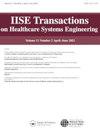基于多源综合数据的弱势社区流动诊所服务需求预测
IF 1.5
Q3 HEALTH CARE SCIENCES & SERVICES
IISE Transactions on Healthcare Systems Engineering
Pub Date : 2020-12-28
DOI:10.1080/24725579.2020.1859305
引用次数: 5
摘要
需求预测在弱势社区(如学区和人口普查区)的移动诊所服务部署中发挥着重要作用,因为它可以帮助服务提供者在有限的资源下最大化其覆盖范围。在本文中,我们考虑了如何预测在学校和人口普查区的疫苗接种违法问题。这样一个问题是相当具有挑战性的,因为犯罪行为只在学校中观察到,而这些学校的信息非常有限;虽然人口普查区有丰富的人口和经济资料,但没有在人口普查区一级观察到犯罪情况。为了应对上述挑战,我们首先开发了一种分层方法来预测学校和人口普查区对疫苗接种的需求。在分层方法的第一阶段,我们解决了一个线性优化模型,以计算一个关联矩阵,该矩阵可以对齐人口普查区和学区的一些共同特征。然后,我们利用估计的关联建立预测模型来预测学校和人口普查区的疫苗接种违法行为。提出了一种非凸二次优化(QO)模型,用于同时寻找关联矩阵和预测模型。我们还引入了一种非凸QO的替代更新方案,并证明了该算法的收敛性。此外,由所提出的方法所产生的两个关联矩阵可用于推算学区数据中的信息,这进一步使我们能够应用现有的预测模型,根据所推算的数据预测学区的需求。一个来自休斯顿独立学区(HISD)及其相关社区的案例研究报告证明了新模型和技术的有效性。本文章由计算机程序翻译,如有差异,请以英文原文为准。
Forecasting the demand of mobile clinic services at vulnerable communities based on integrated multi-source data
Abstract Demand forecasting plays an important role in the deployment of mobile clinic services to vulnerable communities such as school zones and census tracts as it can help the service provider to maximize its coverage under limited resources. In this paper, we consider the issue of how to predict the vaccination delinquency in schools and census tracts. Such an issue is rather challenging as the delinquency is only observed in schools for which very limited information is available; while rich demographic and economic information is available for census tracts, no observations of delinquency have been made at the census tract level. To address the above challenge, we first develop a hierarchical approach to forecast the demand for vaccinations in schools and census tracts. In the first stage of the hierarchical approach, we solve a linear optimization model to compute an association matrix that can align some common features in both census tracts and school zones. Then we use the estimated association to develop a forecasting model to predict the vaccination delinquency in both schools and census tracts. A non-convex quadratic optimization (QO) model is also proposed to find the association matrix and the forecasting model simultaneously. We also introduce an alternative update scheme for the non-convex QO and establish the convergence of the algorithm. Moreover, the two association matrices generated from the proposed approaches can be used to impute the information in the school zone data, which further allows us to apply existing forecasting models to predict the demand in school zones based on the imputed data. A case study from the Houston Independent School District (HISD) and its associated communities is reported to demonstrate the efficacy of the new models and techniques.
求助全文
通过发布文献求助,成功后即可免费获取论文全文。
去求助
来源期刊

IISE Transactions on Healthcare Systems Engineering
Social Sciences-Safety Research
CiteScore
3.10
自引率
0.00%
发文量
19
期刊介绍:
IISE Transactions on Healthcare Systems Engineering aims to foster the healthcare systems community by publishing high quality papers that have a strong methodological focus and direct applicability to healthcare systems. Published quarterly, the journal supports research that explores: · Healthcare Operations Management · Medical Decision Making · Socio-Technical Systems Analysis related to healthcare · Quality Engineering · Healthcare Informatics · Healthcare Policy We are looking forward to accepting submissions that document the development and use of industrial and systems engineering tools and techniques including: · Healthcare operations research · Healthcare statistics · Healthcare information systems · Healthcare work measurement · Human factors/ergonomics applied to healthcare systems Research that explores the integration of these tools and techniques with those from other engineering and medical disciplines are also featured. We encourage the submission of clinical notes, or practice notes, to show the impact of contributions that will be published. We also encourage authors to collect an impact statement from their clinical partners to show the impact of research in the clinical practices.
 求助内容:
求助内容: 应助结果提醒方式:
应助结果提醒方式:


